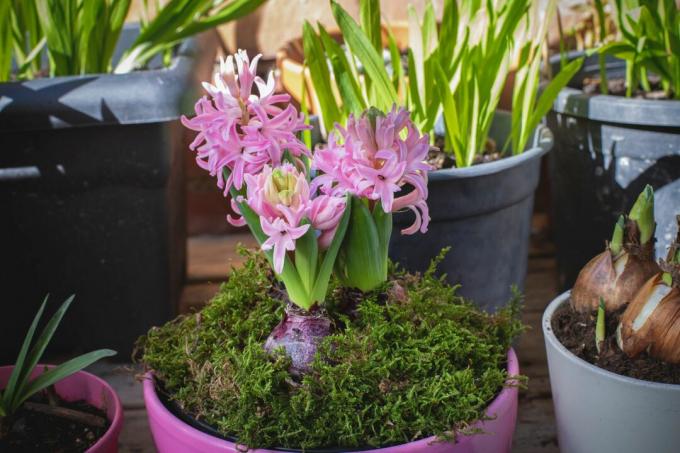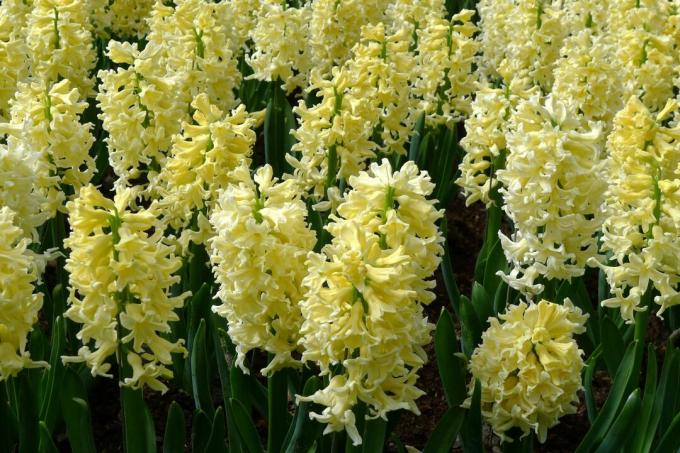Hyacinths are magnificent early bloomers that can also be cultivated indoors. Find out everything about hyacinth species, propagation and planting here.

Hyacinths are one of the classic spring flowers and herald the end of winter with their magnificently coloured, large inflorescences and strong fragrance. We will introduce you to the onion plant and give tips on choosing a variety and planting.
contents
- Hyacinth: flowering time, appearance and meaning
- The colorful variety of hyacinth species and varieties
-
Planting hyacinths: bulbs, location and Co.
- Plant hyacinths in pots
- Plant hyacinths in the garden
- Preparing hyacinth in a glass: this is how it works
- Propagation of Onion Flowers
- Are hyacinths poisonous?
Hyacinth: flowering time, appearance and meaning
hyacinths (Hyacinthus) belong to the asparagus family (Asparagaceae). In Greek mythology, the grieving sun god Apollo created the fragrant flowering plant from the blood of Hyakinthos, who was accidentally killed by his discus throw. All types of hyacinths come from the Orient and are found wild in Turkey, Iran and Israel.
In spring, the hardy bulbous plants sprout long, lanceolate, dark green leaves and a single flower stalk, which is covered with numerous individual flowers. The flowers have no calyx, they are composed of six colored petals. Hyacinths come in all shades of color from pink, red and yellow to deep blue and violet tones. the early bloomers When in bloom between March and May, they emit a heavily perfumed, sweet fragrance that attracts numerous bees and other insects. After flowering, numerous round seeds form in pods that open at maturity. In summer, the hyacinth plant retreats into its bulb and survives in the ground until the following spring.
In the language of flowers, hyacinths symbolize sincerity, love, beauty and happiness, which is why they are often given as gifts.

The colorful variety of hyacinth species and varieties
The genus Hyacinthus includes three species, with only the garden hyacinth (Hyacinthus orientalis) was cultivated and processed by breeding. The wild hyacinth Hyacinthus transcaspicus rarely found in rarity nurseries. Below we present the most beautiful varieties of garden hyacinth.
- 'Blue Pearl': Deep violet flowering hyacinths with bright accents. A rather short cultivar with a height of 25 cm.
- 'Blue Star': Monochrome, blue hyacinth up to 25 cm tall. The variety is very suitable for forcing indoors.
- 'Jan Bos': Bright pink hyacinth with light red markings on the petals. It reaches a growth height of 20 to 40 cm.

- 'Midnight Mystic': Nearly black hyacinth with dark flower stalks and dark green foliage. It stays low and grows to about 20 cm in height. The extremely dark color is only achieved outdoors in direct sunlight.
- 'Odysseus': Attractive, orange-yellow flamed hyacinth with a growth height of up to 40 cm. The fragrant flowers attract numerous insects between April and May.
- 'Pink Pearl': Pink hyacinth variety with a growth height of up to 25 cm. The large, fragrant flowers are easy to grow indoors.
- 'Royal Navy': Rare, double, dark blue-violet hyacinth variety with a growth height of about 20 cm and a pleasant fragrance.

- 'White Pearl': White hyacinth variety with low stature. The small hyacinth grows 15 to 25 cm high. It is easy to cut and exudes a perfumed scent.
- 'Woodstock': Hyacinth with deep red flower color. The variety was created in 1922 and reaches a height of 20 to 30 cm. The red hyacinth is well suited for planting in pots and window boxes.
- 'Yellow Queen': Light, yellow hyacinth with a growth height of up to 40 cm. The plants are covered with numerous flowers and bloom between April and May.

Planting hyacinths: bulbs, location and Co.
Hyacinths are easy-care early bloomers that can be placed in beds or planters. Whether in pots or in the garden, the ideal location for hyacinths is sunny to semi-shady on nutrient-rich, humus-rich and loose soil.
Plant hyacinths in pots
Hyacinths are ideal for planting in pots and window boxes. They are hardy down to -15 °C and can therefore spend the winter outdoors with little protection, such as an insulating layer of jute or fleece. The planter should have good water drainage to avoid waterlogging. A drainage layer of sand, gravel or expanded clay at the bottom of the planter prevents the root and bulb from getting wet and rotting. In order to keep hyacinths in a pot for a long time, it is important to ensure a planting distance of at least 10 cm. A high-quality potting soil, like ours Plantura organic potting soil, has a loose structure and at the same time stores sufficient moisture for the bulbs of the early bloomers. In the spring, plant the bulbs deep enough in the potting soil that the bulb is completely covered. Water properly and place the planter outside.

If you want to keep your hyacinth as a potted plant in your home all year round, it must be kept cool and dark for a period of time to simulate winter. First place the hyacinth only superficially in a pot with soil, most of the bulb sticking out. Pour vigorously once and then place the pot in a cool and dark place. After about eight weeks, it will become apparent that the hyacinth is forming a flowering shoot. Now bring the pot and hyacinth back into the house and leave them in a light and cool place for a few more days. Then she can be put in a warm room.
Plant hyacinths in the garden
The best time to plant hyacinths outdoors is in autumn or early spring. They are preferably placed in small groups of three to five plants. The planting distance for free-standing hyacinth bulbs in the garden is about 15 to 20 cm. First, loosen the soil and work up some compost or a mostly organic slow-release fertilizer – like ours Plantura organic flower fertilizer – to ensure long-term nutrient supply. Soil that is too heavy can be improved with sand or bentonite. The planting depth for hyacinth bulbs is about 10 to 15 cm. First, a deep hole is dug with a hand shovel. Put the hyacinth bulb in with the shoot upwards and fill the planting hole with soil. Once you water, the soil will wash right up to the roots, encouraging growth.
Preparing hyacinth in a glass: this is how it works
Hyacinths can also be cultivated as a living decoration for a short time in a shapely glass with water. Here, too, the bulbs have to be stored in the cold for a few weeks for flowering. Note that only the roots - but not the bulb itself - are in contact with the water. There is a special hyacinth glass for this, but in principle other glasses with a similar shape are also suitable. The water should be renewed every few days. After flowering, the bulbs are best placed in a container with soil or in the bed so that the plant has access to nutrients.

notice: Wax hyacinths are always available in the trade. The onion is completely covered with colored wax. For some time, the hyacinth survives without water and nutrients and even blooms because it can fall back on the reserves in the bulb. In the long run, however, the air and watertight wax does not allow the bulb to breathe or root. The hyacinth does not survive long and therefore cannot be planted.
Propagation of Onion Flowers
The easiest way to propagate hyacinths is to separate and transplant the often numerous, varietal onions from the mother plant. However, the young hyacinth bulbs need a longer cold spell to sprout next year. Detach the bulbs in autumn and store them in a cool place over the winter. Tuck the roots in damp sand to prevent them from drying out completely. The onion itself should remain dry. In early spring, plant the bulbs in a suitable location or put them in a pot.

Are hyacinths poisonous?
All parts of the hyacinth plant are mildly poisonous and excessive consumption can cause vomiting, nausea and other gastrointestinal disorders. As a precaution, hyacinths should therefore be kept out of the reach of pets and children. Hyacinths can also cause skin irritation when touched by sensitive people. It is therefore advisable to always wear gloves when potting and handling.
The undemanding early bloomers require little attention, but there are a few points to consider in order to obtain long-lived and flowering plants. We'll show you what's at the Hyacinth care is to be observed.



